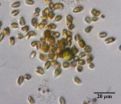(Press-News.org)
VIDEO:
Last year, a team of University of Pennsylvania physicists showed how to undo the "coffee-ring effect, " a commonplace occurrence when drops of liquid with suspended particles dry, leaving a ring-shaped...
Click here for more information.
PHILADELPHIA — Last year, a team of University of Pennsylvania physicists showed how to undo the "coffee-ring effect," a commonplace occurrence when drops of liquid with suspended particles dry, leaving a ring-shaped stain at the drop's edges. Now the team is exploring how those particles stack up as they reach the drop's edge, and they discovered that different particles make smoother or rougher deposition profiles at the drop edge depending on their shape.
These resultant growth profiles offer tests of deep mathematical ideas about growing interfaces and are potentially relevant for many commercial and industrial coating applications.
The new research was conducted by the members of the original team: professor Arjun Yodh, director of the Laboratory for Research on the Structure of Matter; doctoral candidates Peter Yunker and Matthew Lohr; and postdoctoral fellow Tim Still, all of the Department of Physics and Astronomy in Penn's School of Arts and Sciences. New to the collaboration were professor D.J. Durian of the Department of Physics and Astronomy and Alexei Borodin, professor of mathematics at the Massachusetts Institute of Technology.
Their study was published in the journal Physical Review Letters.
In the "coffee-ring effect," drop edges are "pinned" to a surface, meaning that when the liquid evaporates, the drop can't shrink in circumference and particles are convectively pushed to its edges. The Penn team's earlier research showed that this phenomenon was highly dependent on particle shape. Spherical particles could flow under or over each other to aggregate on the edges, but ellipsoidal particles formed loosely packed logjams as they interacted with one another on the surface of the drop.
MIT's Borodin saw the Penn team's earlier experimental videos online, and they reminded him of analytical and simulation work he and others in the math community had performed on interfacial growth processes. These problems had some similarity to the random-walker problem, a classic example in probability theory that involves tracing the path of an object that randomly picks a direction each time it takes a step. In the present case, however, the random motion involved the shape of a surface: the edge of the drop where new particles are added to the system. Borodin was curious about these growth processes in drying drops, especially whether particle shape had any effect.
"Interfacial growth processes are ubiquitous in nature and industry, ranging from vapor deposition coatings to growing bacterial colonies, but not all growth processes are the same," Yunker said. "Theorists have identified several qualitatively distinct classes of these processes, but these predictions have proven difficult to test experimentally."
The two classes of particular interest are "Poisson" and "Kardar-Parisi-Zhang" processes. Poisson processes arise when growth is random in space and time; in the context of an interfacial growth process, the growth of one individual region is independent of neighboring regions. Kardar-Parisi-Zhang, or KPZ, processes are more complicated, arising when growth of an individual region depends on neighboring regions.
A purely mathematical simulation of an interfacial growth process might look like a game of Tetris but with single square blocks. These blocks fall at random into a series of adjacent columns, forming stacks.
In a Poisson process, since individual regions are independent, a tall stack is just as likely to be next to a short stack as another tall stack. Taking the top layers of the stacks as the "surface" of the system, Poisson processes produce a very rough surface, with large changes in surface height from one column to the next.
In contrast, KPZ processes arise when the blocks are "sticky." When these blocks fall into a column, they don't always fall all the way to the bottom but can stick to adjacent columns at their highest point. This means that short columns quickly catch up to their tall neighbors, and the resulting growth surfaces are smoother. There will be fewer abrupt changes in height from one column to the next.
"Many theoretical simulations have demonstrated KPZ processes, a fact which might lead one to think this process should be ubiquitous in nature," Yunker said. "However, few experiments have identified signatures of KPZ processes."
"The relative paucity of identified KPZ processes in experiments is likely due to two main factors," Yodh said. "First, a clean experiment is required; the presence of impurities or particle aggregation can destroy signatures of growth processes. Second, a substantial amount of data must be collected to make comparisons to theoretical predictions.
"Thus, experiments must be very precise and must characterize a wide range of size scales from the particle diameter to the growth fronts. Moreover, they must be repeated many times under exactly the same conditions to accumulate statistically meaningful amounts of homogeneous data."
As in the previous research, the Penn team's experiment involved drying drops of water with differently shaped plastic particles under a microscope. The team measured the growth fronts of particles at the drying edge, especially their height fluctuations — the edge's roughness — over time. When using spherical particles, they found their deposition at the edges of the drop exhibited a classic Poisson growth process. As they tried with increasingly elongated particles, however, the deposition pattern changed.
Slightly elliptical particles — spheres stretched by 20 percent — produced the elusive KPZ class of growth. Stretching the spheres further, 250 percent out of round, produced a third growth process known as KPZQ, or Kardar-Parisi-Zhang with Quenched Disorder. It is also called the "colloidal Matthew effect" as the surface's growth is proportional to the local particle density so that particle-rich regions get richer, while particle poor regions stay poor.
In practical terms, the experiment showed that when spheres and highly stretched particles are deposited, surface roughness grows at a high rate. However, when slightly stretched particles are deposited, surface roughness grows at a relatively slow rate.
The ability to control surface roughness can be important for industrial and commercial applications, as non-uniformity in films and coatings can lead to structural weakness or poor aesthetics. Surface roughness is controlled passively in the team's experiments, making this process potentially attractive alternative for more costly or complicated smoothing processes currently in use.
"Experimental successes are highly valued in the math community," Borodin said. "Not only do they demonstrate real-life applicability of very advanced yet originally purely theoretical research, but they also suggest further directions and even predict yet undiscovered mathematical phenomena."
INFORMATION:
The research was supported by the National Science Foundation through Penn's Materials Research Science and Engineering Center. Peter Yunker is now a post-doctoral fellow at Harvard University.
Penn physicists help show math behind growth of 'coffee rings'
2013-01-19
ELSE PRESS RELEASES FROM THIS DATE:
They hunt, they kill, they cheat: Single-celled algae shed light on social lives of microbes
2013-01-19
Humans do it, chimpanzees do it, cuckoos do it – cheating to score a free ride is a well-documented behavior by many animals, even plants. But microscopically small, single-celled algae? Yes, they do it too, biologists with the University of Arizona's department of ecology and evolutionary biology have discovered.
"There are cheaters out there that we didn't know of," said William Driscoll, lead author of a research report on the topic who studied an environmentally devastating toxic alga that is invading U.S. waters as part of his doctoral research in the lab of Jeremiah ...
Penn Vet study reveals a promising new target for Parkinson's disease therapies
2013-01-19
PHILADELPHIA — With a new insight into a model of Parkinson's disease, researchers from the University of Pennsylvania School of Veterinary Medicine have identified a novel target for mitigating some of the disease's toll on the brain.
Narayan G. Avadhani, Harriet Ellison Woodward Professor of Biochemistry and chair of the Department of Animal Biology at Penn Vet, was the senior author on the research. Other department members contributing to the work included Prachi Bajpai, Michelle C. Sangar, Shilpee Singh, Weigang Tang, Seema Bansal and Ji-Kang Fang. Co-authors from ...
NASA's IRIS spacecraft is fully integrated
2013-01-19
NASA's next Small Explorer (SMEX) mission to study the little-understood lower levels of the sun's atmosphere has been fully integrated and final testing is underway.
Scheduled to launch in April 2013, the Interface Region Imaging Spectrograph (IRIS) will make use of high-resolution images, data and advanced computer models to unravel how matter, light, and energy move from the sun's 6,000 K (10,240 F / 5,727 C) surface to its million K (1.8 million F / 999,700 C) outer atmosphere, the corona. Such movement ultimately heats the sun's atmosphere to temperatures much hotter ...
A microquasar makes a giant manatee nebula
2013-01-19
A new view of a 20,000-year old supernova remnant demonstrates the upgraded imaging power of the National Science Foundation's (NSF) Karl G. Jansky Very Large Array (VLA) and provides more clues to the history of this giant cloud that resembles a beloved endangered species, the Florida Manatee.
W50 is one of the largest supernova remnants ever viewed by the VLA. At nearly 700 light years across, it covers two degrees on the sky – that's the span of four full Moons!
Turbulent History
The enormous W50 cloud formed when a giant star, 18,000 light years away in the constellation ...
Employee Versus Independent Contractor
2013-01-19
Employee versus independent contractor
Most small business owners want to expand their businesses. With expansion comes the need for additional help. Before doing so, however, business owners need to understand the difference between an employee and independent contractor. There can be significant legal consequences for misclassifying workers as independent contractors when they are really employees.
What is an independent contractor?
Independent contractors, sometimes referred to as a freelancers or consultants, are self-employed. They are hired by a business ...
Women Sue National Basketball Association Over Gender Discrimination
2013-01-19
Women sue National Basketball Association over gender discrimination
In the fall of 2012, three women filed suit against the National Basketball Association, or NBA, and its subsidiaries NBA Entertainment and NBA Properties for gender discrimination. The women claim that the NBA changed their work schedules to make it impossible for them to continue to work with the company due to child care concerns.
Lawsuit claims NBA forced working mothers to resign
The women worked for a print group in a creative division of the NBA. In their lawsuit, the plaintiffs claim that ...
Discharging Tax Debts Through Bankruptcy
2013-01-19
Discharging tax debts through bankruptcy
In many cases, people who are overwhelmed by unmanageable income tax debts are able find relief by filing for bankruptcy. However, not all tax debt can be discharged in bankruptcy. It is important to understand the basic requirements when weighing the options for dealing with tax debts. Other debt relief solutions may be available for those whose tax debts do not qualify for discharge in bankruptcy.
When can tax debt be discharged in bankruptcy?
Even if a person has other debts that qualify for discharge during bankruptcy, ...
Sex Crime Detection Software and Your Privacy
2013-01-19
Sex crime detection software and your privacy
When people log onto the popular social networking site Facebook, they expect that their conversations are only read by those given permission through their privacy settings. However, an anonymous, automated presence constantly trolls Facebook accounts, hunting for inappropriate language and the sharing of personal contact information.
This presence is Facebook's sophisticated software created to identify and block people who appear to be soliciting sex online. Some believe its implementation goes too far and violates ...
Pennsylvania Enhancing Enforcement of DUI-Ds
2013-01-19
Pennsylvania enhancing enforcement of DUI-Ds
Pennsylvania police officers are targeting drivers who are driving under the influence of drugs and substances other than alcohol. Driving under the influence of drugs does not just include illegal drugs; instead, prescription drugs and certain medicines obtained over the counter can also cause driver impairment and thereby fall under the DUI statute.
Many Pennsylvania DUIs involve more than just alcohol
According to a Moon Township police officer, the department believes that about half of the drivers charged with DUIs ...
Georgia's Implied Consent Law: What it Means for You
2013-01-19
Georgia's implied consent law: what it means for you
If you are pulled over for driving under the influence (DUI) in Georgia, you may be asked to submit to a blood, breath or urine test. You may wonder if you have to submit to the test or if you can refuse. The answer to these questions lies in Georgia's implied consent law.
Requirements of the law
Under Georgia's implied consent law, in exchange for the privilege of operating a motor vehicle on the state's roadways, the driver is legally deemed to have consented to take a chemical test of his or her blood, breath, ...



